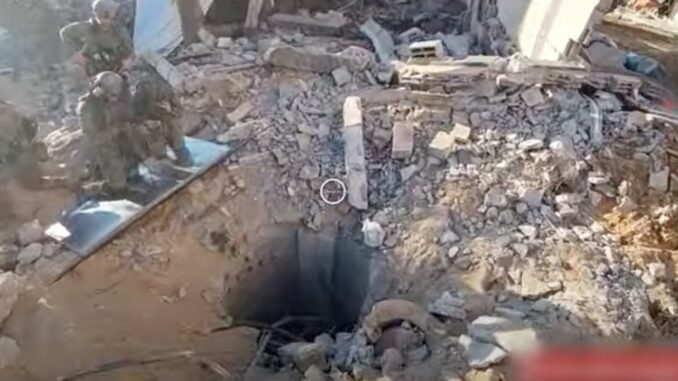
The Israeli military released a statement on Sunday saying it had found a Hamas tunnel shaft under Gaza’s al-Shifa Hospital. It also released footage of tunnels taken on November 17. Here is what the footage tells us:
What happened at al-Shifa?
On November 15, Israel launched an aggressive raid on Gaza’s largest medical complex, al-Shifa Hospital. Lasting for days, the raid was described by Israel as a “precise and targeted” operation to find an alleged underground tunnel system that led to a Hamas military control centre.
list of 4 items
list 1 of 4
Analysis: How would Israel fare in Gaza’s tunnels?
list 2 of 4
Analysis: How would Israel find, map, take and keep Gaza’s tunnels?
list 3 of 4
‘Very risky’: Israel faces months-long campaign against Hamas Gaza tunnels
list 4 of 4
The Take: The Hamas tunnels and al-Shifa Hospital
end of list
The allegation that Hamas was operating a control centre under the hospital was backed by Israeli and United States intelligence. Hamas and medical staff at al-Shifa have denied this allegation.
The Israeli military also released a 3D animated video on October 28, visualising an extensive network of tunnels that led to an elaborate, multi-storey control centre.
(Al Jazeera)
What Israel’s new tunnel video tells us
On Sunday, Israel announced that a 55-metre-long (180ft), 10-metre-deep (32ft) tunnel was found under the hospital.
The statement said that the tunnel was found “in the area of the hospital underneath a shed alongside a vehicle containing numerous weapons including RPGs [rocket-propelled grenades], explosives, and Kalashnikov rifles”.
The Israeli military also released a video that was recorded using two separate cameras on November 17. Spokesperson Daniel Hagari told reporters the entrance was uncovered when a military bulldozer knocked down the outside wall of the hospital, revealing a metallic spiral staircase that descended 10m (32ft) and led to a blast door, which is typically a metallic door with strong closures and hinges, designed to resist explosions. Such doors are usually found on facilities such as bomb shelters.
But military analyst Zoran Kusovac quoted a civil engineer from Gaza who suggested that the video is actually clips of two different tunnels spliced together.
The first section of the video shows the vertical shaft that goes down. It shows features such as load-bearing concrete columns. They seem to be built with regular civil engineering techniques, which would have required large and loud machines such as concrete mixers.
Such a construction could not have been done in secret, the way Hamas tunnels are usually built. The purpose of this construction remains unknown.
The second part of the clip shows the horizontal tunnel. This displays features characteristic of Hamas tunnels — pre-fabricated pieces connected together section by section.
Was a Hamas control centre found under Gaza’s al-Shifa Hospital?
A control centre has not been found so far. Israeli troops have not yet tried to open the blast door at the end of the tunnel that they claim was under al-Shifa, fearing it could be booby-trapped, said Hagari.
Kusovac said that many different types of traps can be placed to prevent tunnel interceptions. Typically, they are improvised explosive devices (IEDs) connected with detonators that can be triggered by tripwire or even light or pressure. They detect the presence of a person entering the tunnel, setting off the explosive. “IEDs are basically like toys the big boys make. The more creative you are, the more successful you are,” said Kusovac.
If armies suspect the presence of such traps, typical regulations are to call explosion experts who arrive and assess the situation. Kusovac said that this usually takes a few hours, not over a day. This time delay brings the veracity of the Israeli military’s claims into question. “You say smoking gun, you get to it and then you don’t show the smoking gun,” he said.
CNN, among other news outlets, visited the exposed tunnel shaft and confirmed the presence of a tunnel, but could not establish whether or not the tunnel led to a command centre.
Does Hamas operate underground tunnels?
Tunnels in Gaza were first built in 1980 at a time when the enclave was under Israeli occupation, and before the formation of Hamas in 1987. They were constructed under the Egyptian border for smuggling all sorts of goods, including weapons, fuel and black market goods.
Over time, Palestinians realised that tunnels could have a military use. The first sign of the military use of tunnels was in 2001 when an Israeli military post was blown up with an explosive from underground. The tunnels entered Israeli public consciousness when Palestinian fighters emerged from a tunnel shaft and kidnapped Israeli soldier Gilad Shalit in 2006.
Israel placed a blockade on the Gaza Strip after Hamas gained control of it in 2007. Tunnels became the means to bypass the siege and to transport food, goods and weapons. Under Hamas, the tunnels expanded strategically.
The tunnels are also used by Hamas for wired communications, since Israel can intercept wireless communications.
After attacking Gaza in 2014, Israel realised the extent and sophistication of the tunnels, then believed to have surpassed 100km (62 miles).
A tunnel war would entail a whole lot of destruction. The magnitude of explosives would be larger and deadlier than usual due to the smaller area of the tunnels. For the same reason, the use of regular ammunition might be too “clumsy” and hence unviable.
Al-Shifa is not the only hospital that Israel has alleged is used by Hamas as a military base. On November 8, Al Jazeera’s verification unit Sanad disproved Israel’s claim that there was a Hamas tunnel under the Sheikh Hamad bin Khalifa Hospital for Rehabilitation and Prosthetics, commonly known as the Qatari Hospital.
Satellite images and archival photos showed that the hatch that Israel claimed was the tunnel entrance was actually part of a water reservoir system that was used to fill therapeutic pools for amputees, water the grounds, and also was an emergency water source.
The structure of the tunnel raises questions about whether it is indeed a Hamas-built pathway.
ENB Top News
ENB
Energy Dashboard
ENB Podcast
ENB Substack



